Nature Conservation 2022 — 25. 5. 2022 — On Nature in the Czech Republic — Print article in pdf
Uranium Spoil Heaps near the Town of Příbram as a Part of Cultural Landscape Heritage and a Threaten

Mineral mining has had a long tradition as an important national economy sector in the Czech Republic. Sites disturbed by mining have become an integral part of the landscape in many regions. The most altered sites include quarries, dumps and heaps, sand- and gravel pits, kaolin mining sites, and slag and fly ash tailing ponds. The traditional negative view of sites affected this way has rapidly been changingamong experts. Early successional (development) stages and diverse habitats with extreme conditions and low productivity, common at such sites, often serve as substitute habitats for many species disappearing from the landscape in the Czech Republic. Several studies demonstrating the considerable conservation potential of these sites come from the Czech Republic.
Spoil heaps in the Příbram area
Spoil heaps in the surroundings of the town of Příbram (Central Bohemia) originated by uranium ore mining in the second half of the 20th century, so they have been a part of the landscape for several decades. For many people, it is difficult to imagine the surroundings of Příbram without them. Spoil heaps were usually established on farmland. After tailings had been dumped, technological and biologi- cal reclamation was carried out. Some dumps were left without reclamation. Technological reclamation primarily consisted of spreading the material to the sides, lowering the top of the dump and altering its slope. The dump plateau was usually levelled and soil was deposited on it. Biological reclamation of spoil heaps included woody plant planting (e.g. pine). To a lesser extent, heaps were just sown with a grass mixture of unspecified species composition.
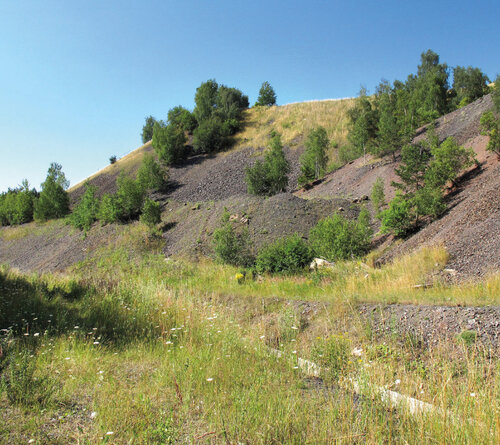
Naturally created, colourful vegetation mosaic at the foot of spoil heap no. 9 near Jerusalem.
© Rudolf Hlaváček
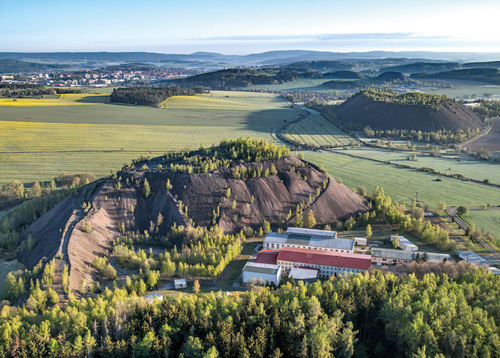
At the foot of spoil heap no. 4 near Lešetice, basic soils rich in cyanolichen communities are found. Several threatened species have been recorded there. © Jiří Jiroušek
Lunar landscape extremes
Stone heaps piled up after uranium mining are a raw substrate, i.e. a site for primary succession. At first sight it may look like a rough, uninhabitable or even toxic landscape. Conditions for plants to settle there are generally unfavourable, sometimes extreme, primarily due to the influence of different abiotic factors. Spoil heaps have steep slopes, so there is strong erosion there and thus a loss of important nu- trients. Surface temperatures of the substrate reach high values in the summer months, causing a lack of water for plants. Other limiting factors are the low fertility of the substrate (particularly low nitrogen and phosphorous contents) and also its physical properties (coarse-grained). Tailings contain heavy metals and sometimes radioactive elements, so the toxicity of the habitat is definitely not negli- gible. All these factors slow down vegetation development, so we can say that the course of succession on uranium spoil heaps in the surrounding of Příbram is delayed by minimally 20 years compared to other areas disturbed by mining.
Spoil heap flora and vegetation
Presently a vegetation gradient can be found on the uranium spoil heaps of Příbram, from nearly bare substrates settled by some of the most resistant bryophytes and lichens to closed-canopy woodland. Many of these woods have been created by natural succession. They are dominated by trees like the Silver birch (Betula pendula), Common aspen (Populus tremula) and the Pussy willow (Salix caprea). The herb layer consists of a very diverse mixture of ruderal, forest and grassland species. To a lesser extent, also other ecological groups are represented there, e.g. species of arable land and rock habitats. The most abundant plants are the Wild strawberry (Fragaria vesca), Bush grass (Calamagrostis epigejos) and the Fireweed (Chamerion angustifolium). Non-native species are strongly represented by invasive alien plants, of which a total of 30 species have been recorded there. The most common plants on the spoil heaps, however, are invasive archaeophytes like the Bulbous oat grass (Arrhenatherum elatius) and the Canada thistle (Cirsium arvense). Common neophytes are the Canadian fleabane (Conyza Canadensis) and the Small balsam (Impatiens parviflora). Other invasive species are seen relatively rarely. An interesting species among the non-native immigrants is the Tall willowherb (Epilobium brachycarpum), a neophyte new to the Příbram area. An already large and numerous population was recorded on spoil heap no. 19 near Dubenec. In the Czech Republic, this species has so far only been found in western Bohemia.
Rare and threatened plants
Two legally protected species have been recorded on the spoil heaps: the Thuringian cinquefoil (Potentilla thuringiaca), found in small numbers on four spoil heaps, and the Basket of gold (Aurinia saxatilis), deliberately sown more than 30 years ago and subsequently spreading over a large area of spoil heap no. 9 near Háje. A total of 35 taxa included in the Red List of Vascular Plants of the Czech Republic (Grulich 2012) have been found on the spoil heaps. Besides the mentioned species these include the strongly endangered Burr chervil (Anthriscus caucalis) and endangered, mostly pioneer species of open habitats, such as the Field cottonrose (Filago arvensis), red hemp-nettle (Galeopsis angustifolia), Childing pink (Petrorhagia prolifera), Annual fescue (Vulpia myuros), Wild parsnip (Pastinaca sativa subsp. urens) and the Common wintergreen (Pyrola minor). Forest species recorded there are e.g. the endemic Bohemian blackberry (Rubus bohemiicola) and further the European barberry (Berberis vulgaris), Broad-leaved hemp nettle (Galeopsis ladanum) and Myosotis sparsiflora.
Regarding threatened taxa, Filago arvensis has gained the most ground, settling bare spots or places only sparsely covered with grass-herb vegetation on gravelly or stony tailings, together with other pioneer plants. Also Pastinaca sativa subsp. urens is locally very successful, sometimes dominating open pioneer vegetation which colonises scree slopes of unfixed tailings.
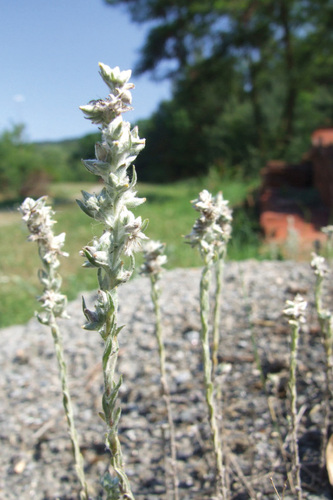
The Field cottonrose (Filago arvensis) is a frequent psammophilous plant on the spoil heaps.
© Jiří Malíček
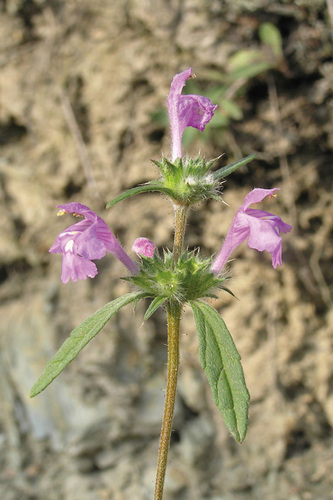
The Red hemp-nettle (Galeopsis angustifolia) is a rare plant of natural scree slopes as well as similar anthropogenic habitats. © Jiří Malíček
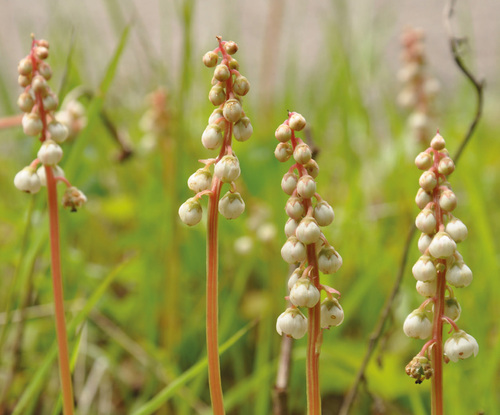
The Common wintergreen (Pyrola minor) is a rare plant in the present Central Bohemian landscape and as well as in the Příbram area. © Jiří Malíček
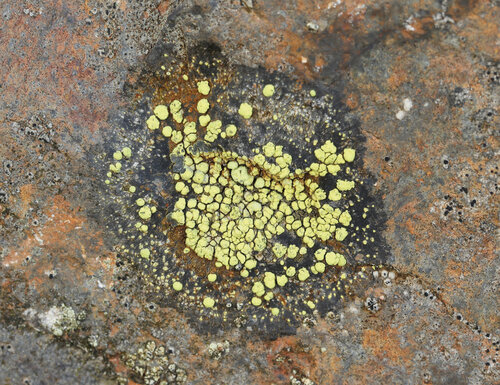
Rhizocarpon ridescens is a lichen which prefers rocky substrates rich in metals. The Příbram spoil heaps are one of its five sites in the Czech Republic. Spoil heap no. 15. © František Bouda
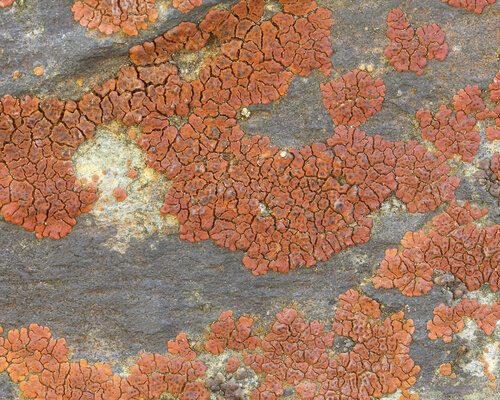
Acarospora sinopica is a characteristic species of communities on silicate stones and rocks enriched with metals. Spoil heap no. 15. © František Bouda
Lichen ecology and diversity
A diversity of life forms can also be found on a smaller scale. Extreme spoil heap habitats have namely been settled by a range of lichens, organisms which thanks to the mutually beneficial symbiosis of a fungus and an alga (or cyanobacterium) manage to grow even on the bare surface of rocks and stones. They can survive there direct sunlight, long drought or exposure to strong frost. Some even tolerate toxic habitats with a high content of metals, and some of them have adapted to such habitats during evolution.
From the perspective of lichen species diversity, some spoil heaps are biodiversity hotspots, as a relatively high number of species grow there compared to the surrounding intensively used farmland. However, not all heaps are favourable for lichens. Their occurrence depends on sev- eral factors: heap age and rate of succession, microclimate and stone size. Old spoil heaps left to natural succession have given lichens sufficient space for their diaspores to be gradually captured, and sites can thus be settled by a diverse range of species. As for microclimate, the species diversity of non-afforested heaps usually increases with growing humidity. The opposite is dry sunlit heaps, where just a few of the most resistant lichens can survive for a longer time. Also stone size is very essential. Too fine material is loose, shifts and does not offer sufficient microhabitats to lichens, and therefore often lichens are completely missing there. Spoil heaps composed of larger stones, on the other hand, may be relatively species-rich. Such types are however rather rare in the Příbram area. Their ecology strongly resembles the stone screes which we can see in e.g. the adjacent Brdy Highlands. Inside they maintain a constant temperature and humidity, so in the summer cold comes out of the lower parts, in winter they release warmth.
Lichen communities
The spoil heaps of Příbram possess a range of interesting substrates for lichens. These are mainly stones, bare soil, but also broadleaved deciduous trees and shrubs. Both acidic silicate and slightly calcareous stones occur there. Substrate variability is supplemented by stones enriched with metals. Each of these types has its own specific physical and chemical properties and also its lichen inhabitants, so that we can find there species with rather different ecological preferences in one place. Saxicolous dominants of most spoil heaps are the common pioneer species Amandinea punctata, Buellia aethalea, Caloplaca holocarpa and Lecanora polytropa. More calcareous rock types are quite reliably indicated by the lichens Candelariella aurella, Protoparmeliopsis muralis and Xanthoria elegans. Substrates enriched with metals are the most interesting from the lichenological point of view. These can be colonised by only a handful of specialised species which are rare elsewhere. Of these, Acarospora sinopica, Lecanora epanora, Rhizocarpon ridescens and Stereocaulon nanodes occur on the spoil heaps of Příbram.
Another suitable substrate is exposed soil. The steep loose slopes of the heaps lack lichens, but at their foot, and sometimes also on top plateaus, many remarkable species can be found. Conspicuous representatives encountered there include e.g. several cup lichen (Cladonia) and felt lichen (Peltigera) species. The cup lichens C. cariosa and C. humilis are relatively rare in the Czech Republic. Also several microlichens, whose presence can easily be overlooked at first sight, appear on the soil. For example, spoil heap no. 11A is only the third site of the inconspicuous Bacidina brandii in the Czech Republic. Probably the most interesting terrestrial lichens of the Příbram spoil heaps are cyanolichens. Their symbiotic partner is not a green alga but a cyanobacterium. They usually have a black thallus which can increase its volume up to several times its original size when humid. Although cyanolichens are found rather sparsely on the spoil heaps, several rare representatives have been recorded there, e.g. Collema limosum, Gregorella humida and three Leptogium species (L. byssinum, L. subtile and L. tenuissimum).
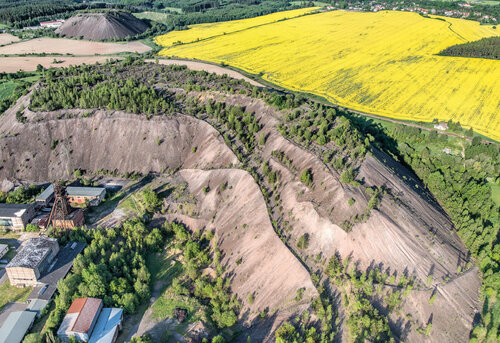
Typical example of a spoil heap with natural succession. Spoil heap no. 15 near Brod. © Jiří Jiroušek
Trees and shrubs growing on the heaps or in their immediate surroundings are an attractive substrate for epiphytic lichens. The bases of the spoil heaps are generally significantly richer in lichens than their top parts, primarily for reason of more favourable microclimatic conditions (most of all humidity). Of the available woody plants, lichens clearly prefer the Common aspen and the Pussy willow, which are characterised by a relatively high bark pH, which is essential for lichens. Nitrophilous lichens, i.e. those associated with a high nutrient level (mainly nitrogen) in the environment, usually prevail on bark. Among them, however, also some less common macrolichens with a foliose or fruticose thallus, like Bryoria fuscescens, Evernia mesomorpha and representatives of the genera Ramalina and Usnea, sometimes appear there.
Conclusions for nature conservation
The spoil heaps in the surrounding of the town of Příbram are a unique landscape element and an extensive example of natural succession. At the same time, they provide a wide range of rare plant and lichen species with suitable habitats. As for plants, this concerns most often weak competitors of early succession stages, which have been still disappearing from the current Central European landscape. For lichens, spoil heaps are moreover a place of high biodiversity and a site of narrowly specialised species.
To preserve the unique flora of the Příbram spoil heaps, the only recommendation which can be made is to leave them without intervention. Reclamation and any other activities disturbing natural succession, causing landslides and shifting of material, are very undesirable for lichens and mostly also unfavourable for vascular plants. The heaps in the surrounding of Lešetice are particularly valuable as they are generally species-rich and host many rare lichen species, primarily the abovementioned specialists preferring substrates rich in metals and also terrestrial cyanolichens.
Present state of uranium spoil heaps
The Czech Republic’s legislation imposes mining operators the obligation to reclaim sites exploited this way. Each company therefore collects the necessary funds in the actual mining period. This obligation also applies to the uranium spoil heaps of Příbram.
At present, some heaps are used as a source of sorted aggregates, have been mined for a great part or are being exploited. Extensive discussions are taking place on the use of other heaps and their possible elimination. By reclaiming the heaps in the form of dislocating the material, the local landscape would lose one of its dominants documenting regional mining activity. The habitats of many threatened organisms would be destroyed. Especially spontaneously developing communities of early succession stages, unique in the current intensively farmed landscape, would disappear. Moreover, the actual reclamation may lead to a release of radioactivity and more dust in the environment. The use of tailings in the construction of roads in the Czech Republic could however be a positive aspect of the planned reclamations.
Concluding, it is clear that uranium heaps must be viewed from many perspectives and decisions about their destiny should be consid- ered carefully – not only from the perspective of human health or economy, but also from the scientific and nature conservation point of view. At the end of 2020, the Ministry of the Environment of the Czech Republic approved partial extraction of the first three Příbram heaps (nos. 11S, 15 and 19) without the need of an EIA procedure. Taking the mentioned arguments into consideration, we think that a comprehensive assessment of this plan in terms of environmental impact should definitely be carried out. ■
- - -
Intro picture: Top plateaus are usually levelled and various material (e.g. building material) is deposited on them. Spoil heap no. 9 near Jerusalem. © Jiří Jiroušek
- - -
List of referencies
DANIHELKA J., CHRTEK J. jr. & KAPLAN Z. (2012): Checklist of vascular plants of the Czech Republic. – Preslia 84: 647–811.
DIAMO, státní podnik, odštěpný závod GEAM (2017): Koncepce likvidace odvalů po těžbě uranu na Příbramsku. Podklad pro diskuzi s odbornou veřejností. – Ms. [Depon. in DIAMO, Příbram.]
FIŠEROVÁ Š. (2016): Vliv těžební činnosti na krajinný ráz v okolí města Příbram. – Ms. [Diplomová práce; depon. in knih. Fakulty humanitních studií UK v Praze.]
KOLÁŘ F. et. al. (2012): Ochrana přírody z pohledu biologa: proč a jak chránit českou přírodu. – Praha: Dokořán.
Malíček J., Bouda F., Konečná E., Peksa O. & Syrovátková L. (2021): Lišejníky zaznamenané během bryologicko-lichenologického setkání ve Spáleném Poříčí, září 2020. – Bryonora 67: xx–xx.
Malíček J., Palice Z., Knudsen K., Šoun J., Vondrák J. & Novotný P. (2021): Atlas českých lišejníků. – dalib.cz [28. 04. 2021]
PRACH K. (1987): Succession of vegetation on dumps from strip coal mining, N. W. Bohemia, Czechoslovakia. – Folia Geobotanica et Phytotaxonomica 22: 339–354.
PRACH K. et al. (2009): Ekologie obnovy narušených míst. 1. Obecné principy. – Živa 1/2009: 22–24.
PYŠEK P. et al. (2012): Catalogue of alien plants of the Czech Republic (2nd edition): checklist update, taxonomic diversity and invasion patterns. – Preslia 84: 155–255.
TICHÝ L. et al. (2020): Central-European vegetation types and their optima along successional gradient. – Preslia 92: 341–352.
TROPEK R. & PRACH K. (2012): Místa narušená těžbou. – In: JONGEPIEROVÁ I. et. al.: Ekologická obnova v České republice. Praha: Agentura ochrany přírody a krajiny České republiky.
VEJVODOVÁ K. (2020): Dlouhodobé sukcesní změny vegetace na výsypkách po těžbě uranu. – Ms. [Diplomová práce; depon. in knih. Katedry botaniky PřF JČU, České Budějovice.]
VIŠŇÁK R. (2016): Botanický průzkum odvalů uranových dolů v oblastech Příbram a Rožná. – Ms. [Depon. in Archív DIAMO.]

